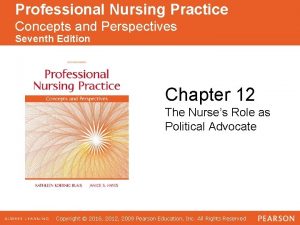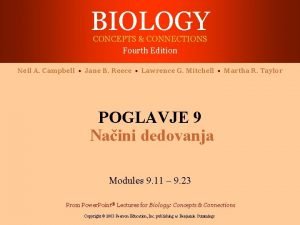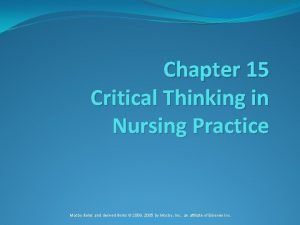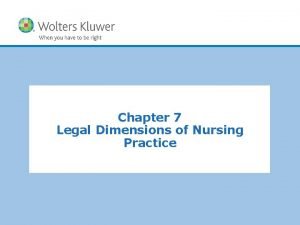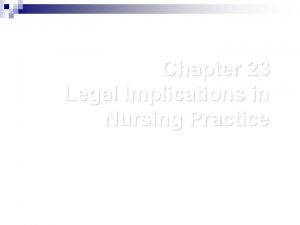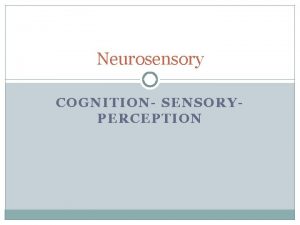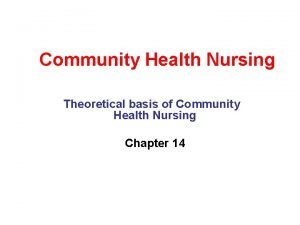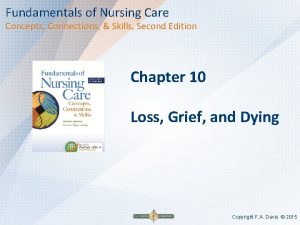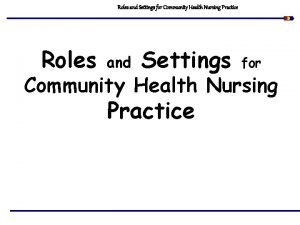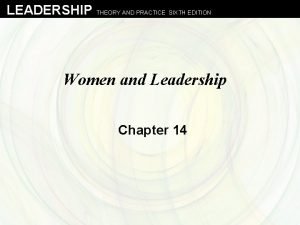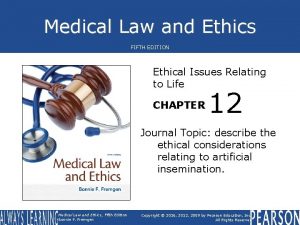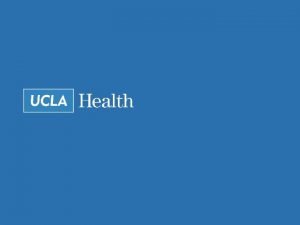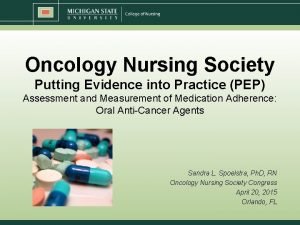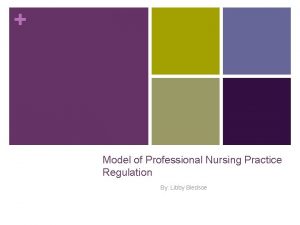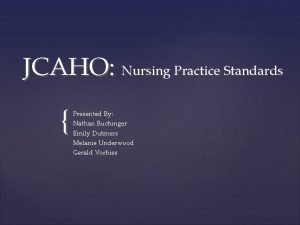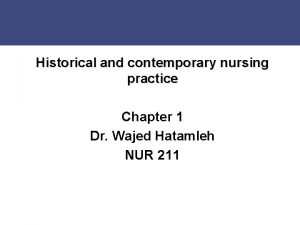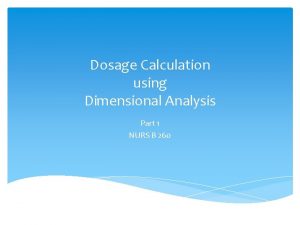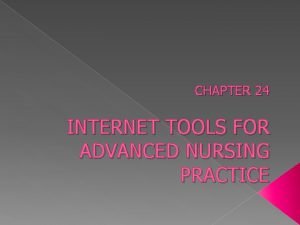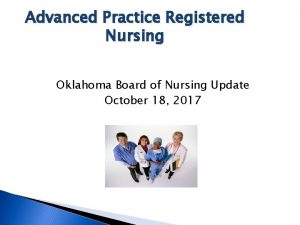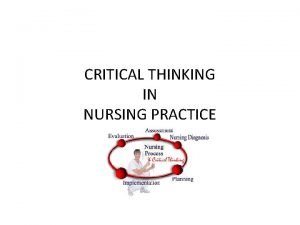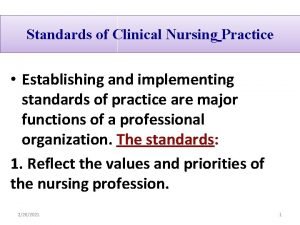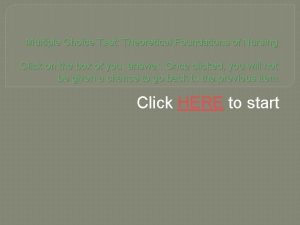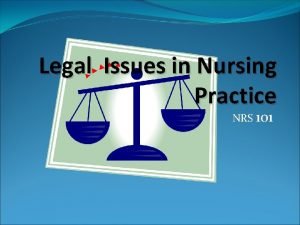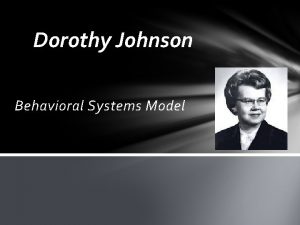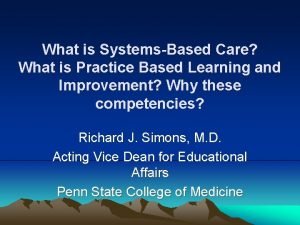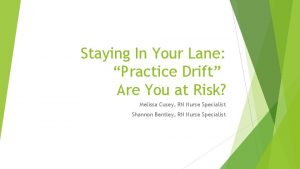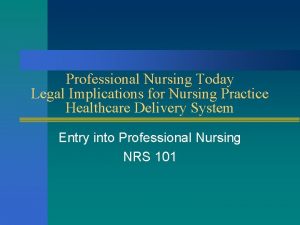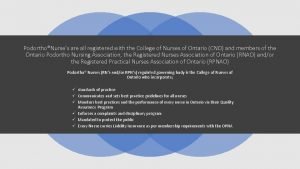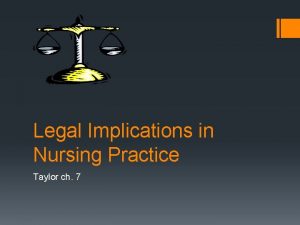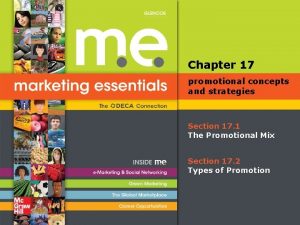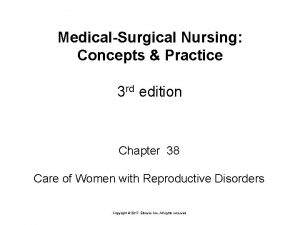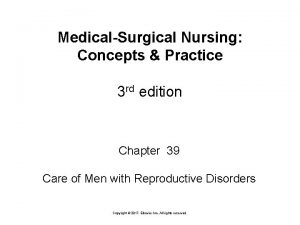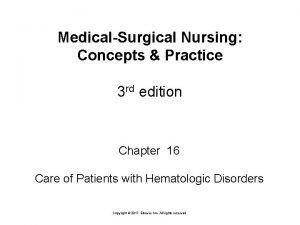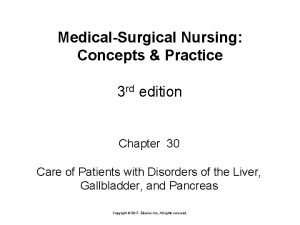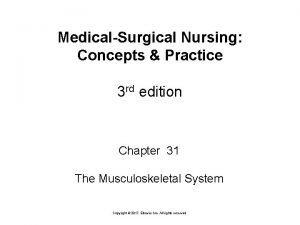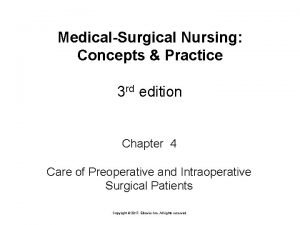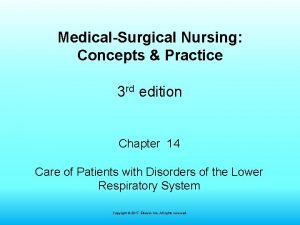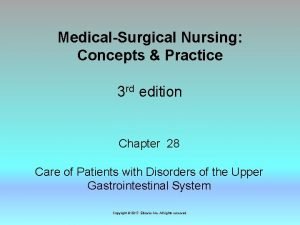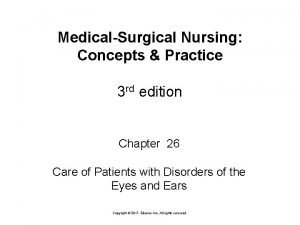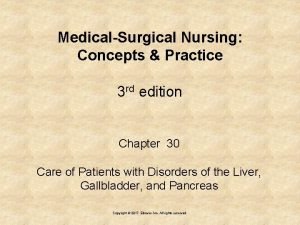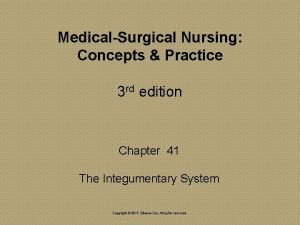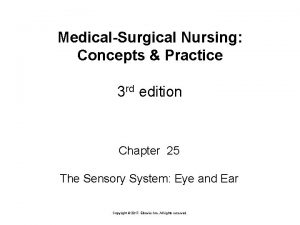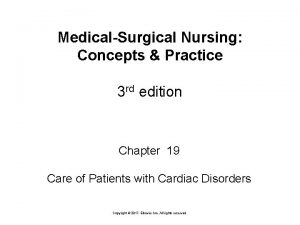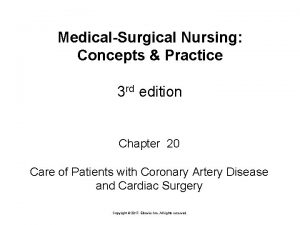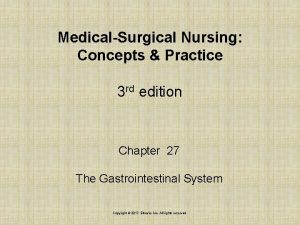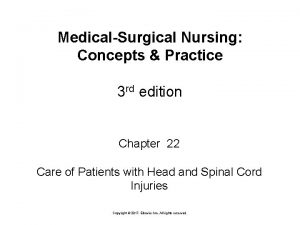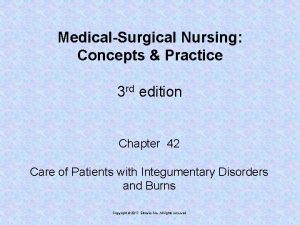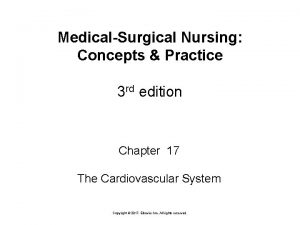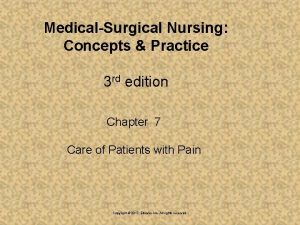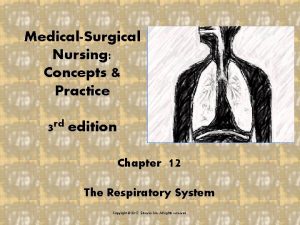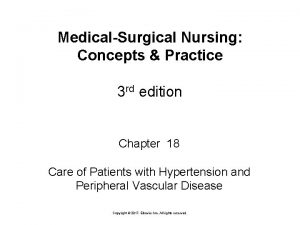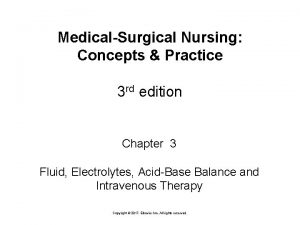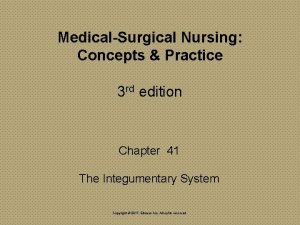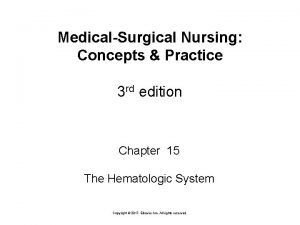MedicalSurgical Nursing Concepts Practice 3 rd edition Chapter
























![Leukocytosis An increased number of leukocytes (white blood cells [WBCs]), usually seen at the Leukocytosis An increased number of leukocytes (white blood cells [WBCs]), usually seen at the](https://slidetodoc.com/presentation_image_h/13f2cd9b8bd1d3c1eadd4362bc34779a/image-25.jpg)




































- Slides: 61

Medical-Surgical Nursing: Concepts & Practice 3 rd edition Chapter 6 Infection Prevention and Control Copyright © 2017, Elsevier Inc. All rights reserved.

Theory Objectives Analyze the factors that increase the risk of infection. Discuss how the body uses its natural defensive mechanisms to protect against infection. Explain how fever plays a role in the prevention of infection. Describe the classic signs of infection. Copyright © 2017, Elsevier Inc. All rights reserved. 2

Theory Objectives (Cont. ) Analyze situations that require the use of Expanded Precautions. List the types of personal protective equipment and analyze situation for when they should be used. Describe factors that make older adults more susceptible to infections. Analyze factors that may impair the process of healing and repair of damaged tissue. Copyright © 2017, Elsevier Inc. All rights reserved. 3

Clinical Practice Objectives Care for a patient whose condition requires transmission-based precautions From a day's patient assignment, determine the factors present for each patient that are risk factors for infection. Copyright © 2017, Elsevier Inc. All rights reserved. 4

Infectious Process and Disease An infection is the presence and growth of pathogenic microorganisms in a susceptible (lacking resistance) host, to the extent that tissue damage occurs. The development of an infection depends n the interrelationship between the host, the agent, and the environment. (see page 100) Box 6 -1 Copyright © 2017, Elsevier Inc. All rights reserved. 5

Infectious Process and Disease (Cont. ) Communicable (passed from one person to another) or noncommunicable When an infection has occurred, the person is considered communicable until the host is no longer shedding infectious organisms. This period of communicability varies by the type of pathogen involved and the host’s ability to fight off the infecting agent. Copyright © 2017, Elsevier Inc. All rights reserved. 6

Factors that Influence Infection and Disease (Box 6 -1) Risk of exposure Ø Host characteristics Ø Lifestyle, occupation, and socioeconomic status Immunologic and nutritional status influence resistance or susceptibility to the pathogen Environmental factors Copyright © 2017, Elsevier Inc. All rights reserved. 7

Disease-Producing Pathogens Disease-producing pathogens include any microorganism capable of producing disease. Modes of transmission are airborne, contact, and droplet. Ø Hand hygiene and respiratory etiquette—cover your cough or sneeze and performing hand hygiene afterward. Copyright © 2017, Elsevier Inc. All rights reserved. 8

Categories of Microorganisms Bacteria (antibiotics) Viruses (antivirals) Protozoa Rickettsia and chlamydia Fungi (antifungals) Mycoplasma Others (helminths –worms and prions) Copyright © 2017, Elsevier Inc. All rights reserved. 9

The Body’s Defenses Against Infection The four primary lines of defense the body has against infection are Ø Ø Skin and mucous membranes Normal flora Inflammatory response Immune response Copyright © 2017, Elsevier Inc. All rights reserved. 10

Skin and Mucous Membranes Mechanical barrier Ø Ø Intact skin and mucous membranes provide a protective covering for the more delicate and vulnerable underlying tissues and organs. Serve as portals of exit and entry Chemical barriers Ø Ø Ø Acids Lysozymes Cilia Copyright © 2017, Elsevier Inc. All rights reserved. 11

Normal Flora Present on skin and in mucous membranes of the oral cavity, gastrointestinal tract, and vagina Help prevent excessive growth of pathogens Copyright © 2017, Elsevier Inc. All rights reserved. 12

Inflammatory Response. . 2 nd line of defense Basic purposes of the inflammatory response include Ø Ø Ø Neutralizing and destroying harmful agents Limiting spread to other tissues in the body by walling off organisms Preparing the damaged tissues for repair Copyright © 2017, Elsevier Inc. All rights reserved. 13

Inflammatory Changes Inflammatory changes involve Ø Ø Ø The cells of the damaged tissues and adjacent connective tissues The blood vessels in and near the site of injury The blood cells, particularly the leukocytes The macrophages and phagocyte activity The immune system The hormonal system Copyright © 2017, Elsevier Inc. All rights reserved. 14

Signs and Symptoms of Inflammation Local reactions—redness, heat, swelling, and pain Systemic reactions—headache, myalgia, fever, diaphoresis, chills, anorexia, and malaise Chemical release and vascular changes Immune response—the third line of defense Hormonal response Copyright © 2017, Elsevier Inc. All rights reserved. 15

Protective and Defensive Mechanisms Against Infection Innate (born with or natural) see Box 6 -2 pg 103 Acquired immunity (develops throughout life) Host susceptibility Ø Degree of susceptibility depends on general health, state of nutrition, hormone balance, immune status, and the presence of a chronic disease such as diabetes mellitus Copyright © 2017, Elsevier Inc. All rights reserved. 16

Mechanisms Against Infection Antigen and antibodies Bone marrow Leukocytosis Phagocytosis Macrophages Liver cells Copyright © 2017, Elsevier Inc. All rights reserved. 17

Antigen and Antibodies An antigen is a form of protein found on the outside of cells that has the ability to identify it as “self” (native) or “nonself” (foreign). Ø It can stimulate the immune response to wipe out microorganisms. Antibodies, also known as immunoglobulins (Ig), neutralize toxins and kill invading pathogens. Ø Ig. M, Ig. G, Ig. A, Ig. E, Ig. D Copyright © 2017, Elsevier Inc. All rights reserved. 18

Ig. M Antibody Appears first if the body is exposed to an antigen Will bind to the antigen and work to clear the pathogen from the body Copyright © 2017, Elsevier Inc. All rights reserved. 19

Ig. G Antibody Most abundant immunoglobulin found in the body and is the only one that crosses the placental barrier Can also be given to provide passive immunity until the body’s own immune system can defend itself Copyright © 2017, Elsevier Inc. All rights reserved. 20

Ig. A Antibody Found in tears, mucus, saliva, gastric fluid, colostrum, and sweat Prevents pathogens from attaching to or penetrating epithelial cells, such as the skin Copyright © 2017, Elsevier Inc. All rights reserved. 21

Ig. E Antibody Has the ability to bind to mast cells and basophils and when triggered, releasing histamine and heparin This in turn stimulates a hypersensitive reaction, as seen in bronchial asthma or systemic anaphylaxis. Copyright © 2017, Elsevier Inc. All rights reserved. 22

Ig. D Antibody Ig. D works together with Ig. M. Stimulates certain cells in the immune system; however, its overall role in the immune response is still unclear Copyright © 2017, Elsevier Inc. All rights reserved. 23

Bone Marrow Plays an important role in the manufacturing of blood products that help the body defend itself against infection Copyright © 2017, Elsevier Inc. All rights reserved. 24
![Leukocytosis An increased number of leukocytes white blood cells WBCs usually seen at the Leukocytosis An increased number of leukocytes (white blood cells [WBCs]), usually seen at the](https://slidetodoc.com/presentation_image_h/13f2cd9b8bd1d3c1eadd4362bc34779a/image-25.jpg)
Leukocytosis An increased number of leukocytes (white blood cells [WBCs]), usually seen at the beginning of an infection when the person’s immune system has not been overly stressed Leukocytosis is seen more often with bacterial than viral infections. **** When infection does occur, the bone marrow is stimulated to produce and release more leukocytes to help the body fight off, inactivate, and destroy the invading pathogens. Copyright © 2017, Elsevier Inc. All rights reserved. 25

Phagocytosis Ingestion and digestion of bacteria Assists the body in destroying invading pathogens The body’s first line of defense at the cellular level Within the first few hours of the onset of the inflammatory process, monocytes swell (becoming macrophages) and migrate to the site of inflammation. Neutrophils, a type of leukocyte, are released and kill aerobic and anaerobic organisms. After the macrophages and neutrophils engulf and destroy bacteria and other foreign matter, they die, producing an exudate (pus) composed of tissue, fluid, dead cells, and their byproducts. Copyright © 2017, Elsevier Inc. All rights reserved. 26

Macrophages Monocytes (large leukocytes) that have left the bloodstream and migrated into the tissues They ingest and destroy pathogens and clear away the cellular debris and dead neutrophils in the latter stages of an infection. Macrophages cleanse the lymphatic fluid as it passes through the lymph nodes and perform a similar action on the blood as it passes through the liver and spleen. Copyright © 2017, Elsevier Inc. All rights reserved. 27

Liver Cells As part of the innate immune system, about 50% of all macrophage cells can be found in the liver’s Kupffer cells. These macrophages prevent invasion mechanically or neutralize the pathogen chemically (through the p. H of body secretions). Macrophages also have the ability to destroy bacteria that have found their way into the blood circulation through the liver’s portal system. Copyright © 2017, Elsevier Inc. All rights reserved. 28

Chain of Infection Prevention or control of infection is aimed at interrupting any point within the chain of infection. See p 107 Figure 6 -3 Copyright © 2017, Elsevier Inc. All rights reserved. 29

Vectors Can transmit pathogens through their bites or stings Mosquitoes Fleas Ticks Flies Copyright © 2017, Elsevier Inc. All rights reserved. 30

Reservoirs Any place a pathogen is normally found Can be animate (living) such as people, animals, and insects Can be inanimate (nonliving), as found in soil, in water, and on surfaces of objects such as a cup or bed rails Copyright © 2017, Elsevier Inc. All rights reserved. 31

Infection Prevention and Control Perform diligent hand hygiene. Remove rings, other jewelry, and artificial fingernails or extenders. Copyright © 2017, Elsevier Inc. All rights reserved. 32

Standard Precautions – see Box 6 -4 page 108 Designed to prevent transmission of microorganisms from one patient to another and protect health care workers from unnecessary exposure to infection Used on all patients because their potential for being colonized or actual infections are not always known Copyright © 2017, Elsevier Inc. All rights reserved. 33

Standard Precautions (Cont. ) Barrier precautions, such as gloves or isolation techniques that include the proper handling and disposal of secretions, excretions, and exudates, can prevent the transmission of pathogens from one person or object to another. Copyright © 2017, Elsevier Inc. All rights reserved. 34

Transmission-Based Precautions – see Table 6 -5 pg. 109 Airborne infection isolation = TB, varicella Contact isolation= MRSA, VRE ESBL + Droplet isolation = Pneumonia, influenza, strep, meningitits Copyright © 2017, Elsevier Inc. All rights reserved. 35

Personal Protective Equipment (PPE) The use of some type of barrier to protect a person from exposure to bloodborne pathogens, body fluids, or other potentially infectious materials Ø Ø Ø Gloves (consider latex allergy) Cover gowns Facemasks Eye protection Respirator masks Copyright © 2017, Elsevier Inc. All rights reserved. 36

Transplant Recipients Special airflow and filtration rooms with positive air pressure Smooth surfaces to aid in disinfection Minimize the length of time the patient is outside of the protective environment. Ensure staff are free from signs and symptoms of illness. Copyright © 2017, Elsevier Inc. All rights reserved. 37

Respiratory Hygiene Disposal of soiled materials Hand hygiene Copyright © 2017, Elsevier Inc. All rights reserved. 38

Cough Etiquette Turning or covering the mouth when coughing Hand hygiene Copyright © 2017, Elsevier Inc. All rights reserved. 39

Interrupting Portal of Entry Use clean or sterile items. Use effective hand hygiene techniques. Immunization and measures to boost immunity through proper nutrition and a healthy lifestyle Copyright © 2017, Elsevier Inc. All rights reserved. 40

Health Care–Associated Infections (HAIs) There a number of sources of infection in care settings. Specific criteria that must be met for an infection to be consider an HAI. • Such as length of time in a facility before the onset of the infection Copyright © 2017, Elsevier Inc. All rights reserved. 41

Costs of HAIs Human suffering Prolonged hospital stays Time lost from work Copyright © 2017, Elsevier Inc. All rights reserved. 42

Nursing Interventions to Prevent HAIs Hand hygiene Reduce vascular catheter–related infections Appropriate disposal of soiled or contaminated linens Review immunization status of the patient Copyright © 2017, Elsevier Inc. All rights reserved. 43

Infection Surveillance and Reporting Assess for signs and symptoms of infection. Ø Ø Ø Ø Unexpected elevation of temperature Malaise Cough Loss of appetite Foul-smelling urine New-onset diarrhea Wounds that are red, swollen, painful, or have a foul-smelling discharge Color of purulent drainage Copyright © 2017, Elsevier Inc. All rights reserved. 44

Infection Surveillance and Reporting (Cont. ) Identify patients who are more susceptible to infection because they Ø Ø Ø Are weakened by severe illness or injury Have drainage tubes or catheters, intravenous cannulas, or other invasive devices for monitoring or treatment Are very young or very old Have had recent surgery Are immunocompromised Copyright © 2017, Elsevier Inc. All rights reserved. 45

Destroying and Containing Infectious Agents Goals of destroying and containing infectious microorganisms are achieved by techniques and methods that Ø Ø Kill the organisms or render them harmless Isolate the sources of infection, so that they cannot be spread to others This is accomplished through medical or surgical aseptic technique. Copyright © 2017, Elsevier Inc. All rights reserved. 46

Medical Asepsis Goal is to reduce microorganisms Ø Ø Hand hygiene Separation or isolation of a patient Appropriate precautions for handling and disposing of contaminated articles Cleansing and disinfection Copyright © 2017, Elsevier Inc. All rights reserved. 47

Surgical Asepsis Goal is to completely eliminate microorganisms Ø Ø Ø Sterilizing of instruments, skin, linen, and other articles Intravenous catheter insertion Indwelling Foley catheter insertion Placement of internal devices Invasive procedures Surgically aseptic environment Copyright © 2017, Elsevier Inc. All rights reserved. 48

Sepsis and Septic Shock Bacteremia Systemic inflammatory response syndrome (SIRS) Septic shock Multiorgan failure Copyright © 2017, Elsevier Inc. All rights reserved. 49

Assessment (Data Collection) Thorough nursing assessment of subjective and objective data Assess mental status, temperature, edema, pulse, blood pressure, and urine output. Watch for signs and symptoms of septic shock. Copyright © 2017, Elsevier Inc. All rights reserved. 50

Older Adult Care Points Note the physiologic changes of aging. Ø Ø Decreased inflammatory and immune response; little rise in temperature in the presence of infection Decrease in mental alertness; increased fatigue; or sudden onset of confusion, irritability, or apathy Copyright © 2017, Elsevier Inc. All rights reserved. 51

Planning Use the body’s own defensive and healing processes. Obtain adequate rest, nutrition, and hydration. Be as free from physical discomfort as possible. Be free from as much mental anxiety or depression as possible. Ensure that sufficient oxygen and blood are supplied to the infected tissues. Copyright © 2017, Elsevier Inc. All rights reserved. 52

Implementation Provide a quiet, comfortable environment. Relieve the discomforts of fever and muscle aches, accomplished by tepid sponge baths, ice bags, antipyretics, and massage. Warm compresses and the application of heat, as appropriate, can also promote healing. Mild physical exercise promotes circulation and helps some patients to relax. Copyright © 2017, Elsevier Inc. All rights reserved. 53

Implementation (Cont. ) Administer antimicrobial agents. Maintain medical asepsis. Monitor laboratory tests. Ø Elevated WBC count, changes in the distribution and number of the various types of leukocytes, an elevated erythrocyte sedimentation rate (ESR), and microbiology cultures that test positive for microorganisms Copyright © 2017, Elsevier Inc. All rights reserved. 54

Implementation (Cont. ) Ø Bacteriologic tests • Culture and sensitivity—multidrugresistant organisms • Intradermal skin tests—tuberculosis, coccidioidomycosis, and candidiasis • Radiography (x-rays), computed tomography (CT), or magnetic resonance imaging (MRI) may be used to detect changes in the tissues or organs, and locate abscesses anywhere within the body. Copyright © 2017, Elsevier Inc. All rights reserved. 55

Patient Teaching Provide patient and family teaching regarding the infection, including the following. Ø Ø Ø Purposes of diagnostic tests Treatments Special precautions Copyright © 2017, Elsevier Inc. All rights reserved. 56

Evaluation Temperature, pulse, and respirations are within normal range. WBC count and ESR are within normal limits and cultures are negative. Able to rest comfortably Absence of or decrease in severity of pain and discomfort Fluid and nutritional needs are being met. Copyright © 2017, Elsevier Inc. All rights reserved. 57

Community Care Goals Promote sanitary standards in communities. Identify persons who are highly susceptible to infection and reduce their chances of developing an infectious disease. Provide immunization programs to protect people against certain infectious diseases. Copyright © 2017, Elsevier Inc. All rights reserved. 58

Home Care Hand hygiene Clean surfaces Safe food handling Get immunized. Use antibiotics appropriately. Be careful with pets. Avoid contact with wild animals. Copyright © 2017, Elsevier Inc. All rights reserved. 59

Audience Response Question 1 Cross-infection among members of the household can be prevented by which behavior(s)? (Select all that apply. ) 1. 2. 3. 4. 5. Sharing personal items Practicing hand hygiene Using bleach to clean surfaces Sealing used dressings in impermeable bags Washing soiled linens weekly Copyright © 2017, Elsevier Inc. All rights reserved. 60

Long-Term Care Older adults are more susceptible to infection. Chronic illnesses Hand hygiene Cleaning surfaces Meticulous and timely skin care Appropriate management of soiled linens Copyright © 2017, Elsevier Inc. All rights reserved. 61
 Professional nursing practice 7th edition
Professional nursing practice 7th edition Professional nursing practice concepts and perspectives
Professional nursing practice concepts and perspectives Human genetics concepts and applications 10th edition
Human genetics concepts and applications 10th edition Operating system
Operating system Operating system concepts 6th edition
Operating system concepts 6th edition Chords rule in dbms
Chords rule in dbms Biology concepts and connections 4th edition
Biology concepts and connections 4th edition Mis chapter 6
Mis chapter 6 Zulily case study
Zulily case study Critical thinking model nursing
Critical thinking model nursing Chapter 7 legal dimensions of nursing practice
Chapter 7 legal dimensions of nursing practice Chapter 23 legal implications in nursing practice
Chapter 23 legal implications in nursing practice Cost-benefit analysis concepts and practice
Cost-benefit analysis concepts and practice Interrelated concepts nursing
Interrelated concepts nursing Public health nursing principles
Public health nursing principles Fundamentals of nursing care concepts connections & skills
Fundamentals of nursing care concepts connections & skills Roles of a community health nurse
Roles of a community health nurse Leadership theory and practice 6th edition
Leadership theory and practice 6th edition Computer security principles and practice
Computer security principles and practice Modern real estate practice in pennsylvania
Modern real estate practice in pennsylvania Medical law and ethics 5th edition
Medical law and ethics 5th edition Computer security principles and practice 4th edition
Computer security principles and practice 4th edition Dr ruth yates
Dr ruth yates Myeplg
Myeplg Unit practice council nursing ideas
Unit practice council nursing ideas Putting evidence into nursing practice
Putting evidence into nursing practice Model of professional nursing practice regulation
Model of professional nursing practice regulation What is jcaho
What is jcaho Define nursing
Define nursing How to calculate gtts/min
How to calculate gtts/min Internet tools for advanced nursing practice
Internet tools for advanced nursing practice Oklahoma board of nursing supervising physician
Oklahoma board of nursing supervising physician Neuman's system model
Neuman's system model Define critical thinking in nursing
Define critical thinking in nursing Standards of clinical nursing practice
Standards of clinical nursing practice Theoretical foundation of nursing exam
Theoretical foundation of nursing exam Legal issues in nursing practice
Legal issues in nursing practice Johnson's behavioral system model in nursing practice
Johnson's behavioral system model in nursing practice Translating research findings to clinical nursing practice
Translating research findings to clinical nursing practice Systems-based practice
Systems-based practice 14 components of henderson theory
14 components of henderson theory Practice drift in nursing
Practice drift in nursing Abraham maslow siblings
Abraham maslow siblings Fl nurse practice act
Fl nurse practice act Legal implications in nursing practice
Legal implications in nursing practice Podortho nursing program
Podortho nursing program Legal implications of nursing documentation
Legal implications of nursing documentation Staffing and nursing care delivery models
Staffing and nursing care delivery models Obsessive compulsive disorder nursing interventions
Obsessive compulsive disorder nursing interventions Pre and post operative nursing care of cataract
Pre and post operative nursing care of cataract How to write a care plan
How to write a care plan Nursing process in psychiatric nursing
Nursing process in psychiatric nursing Chapter 17 promotional concepts and strategies
Chapter 17 promotional concepts and strategies Chapter 33 entrepreneurial concepts
Chapter 33 entrepreneurial concepts Chapter 15 developing fraction concepts
Chapter 15 developing fraction concepts A survey of probability concepts chapter 5 solutions
A survey of probability concepts chapter 5 solutions Promotional concepts and strategies
Promotional concepts and strategies The five basic concepts of democracy
The five basic concepts of democracy Chapter p prerequisites
Chapter p prerequisites Chapter p prerequisites fundamental concepts of algebra
Chapter p prerequisites fundamental concepts of algebra Chapter p prerequisites fundamental concepts of algebra
Chapter p prerequisites fundamental concepts of algebra 1. part one—analyzing accounting concepts and procedures
1. part one—analyzing accounting concepts and procedures

